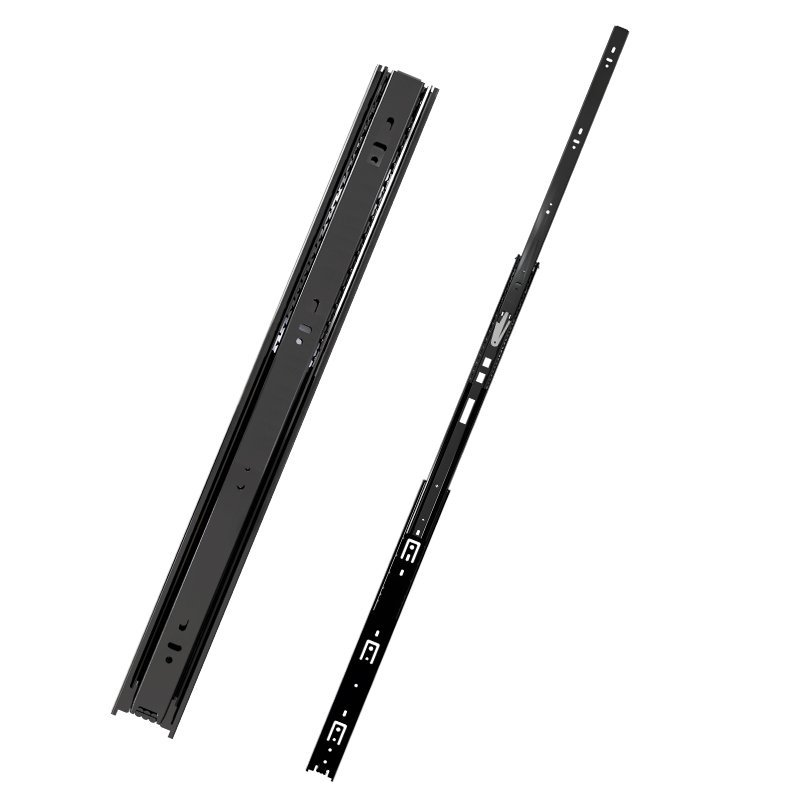Use
Explore our high-performance home improvement drawer rail for an unmatched smooth feel and exceptional load-bearing capacity.
Whether you need a standard model or a custom solution, we have you covered.

Ball bearing
High-quality ball bearing design for extremely smooth and almost silent sliding

Material selection
* Other materials can also be customized
Special Features
Load-bearing capacity
Our slides have a load-bearing capacity of up to 500 lbs, ensuring they can easily withstand all kinds of heavy objects and give you the most reliable support.
serve
Provide technical support
Compatible with almost all furniture on the market
You may be interested
What are the three common types of drawer guides?
The three most common types of drawer guides are:
Roller Guides: These use small pulleys to allow the drawer to slide smoothly. They are generally more economical but have lower load-bearing capacity and durability.
Ball Bearing Guides: These use ball bearings to reduce friction, providing a smoother and quieter sliding experience. They have a higher load-bearing capacity and a longer lifespan, making them suitable for highly loaded drawers.
Heavy Duty Guides: These are designed to withstand heavier loads, are usually made of sturdy metal materials, and have a higher load-bearing capacity and durability, making them suitable for use with heavier drawers or in harsh environments.
How does a drawer guide work?
Drawer guides provide smooth sliding support between the drawer and the cabinet, ensuring that the drawer can open and close smoothly. Specifically, drawer guides usually consist of the following parts:
Guide rail: This is the main part fixed to the side of the drawer and the inside of the cabinet. The rail is usually long and may be made of steel or other durable materials.
Slide assembly: The slide assembly is installed on the guide rail and usually includes pulleys, ball bearings, or balls. The slide assembly enables the drawer to move smoothly on the track and reduce friction.
Guide mechanism: The guide mechanism helps maintain the stability of the drawer on the track and prevents the drawer from shaking left and right or falling off the track. This can be achieved through designed grooves, slides, or guide brackets.
When in use, when the drawer is pulled out or pushed in, the slide assembly moves on the track, reducing the friction between the drawer and the track, and making the drawer open and close more smoothly and quietly. Different types of guides (such as pulley guides, ball bearing guides, and heavy-duty guides) optimize the sliding performance of the drawer through different structures and materials to meet different usage needs.
What are the rails on drawers called?
The “tracks” on a drawer are often called drawer rails. These rails include:
Drawer Rails: Fixed to the sides of the drawer and inside the cabinet, used to support the sliding of the drawer.
Rail Bars: Sometimes also used to refer to the metal bars in the drawer rails that provide structural support.
Sliding Rails: Refers to the sliding part of the drawer that allows the drawer to slide in and out smoothly.
These rails ensure the smoothness and stability of the drawer when opening and closing.
What are the wheels on a drawer called?
The “wheels” on a drawer are often called pulleys or rollers. They are part of the drawer rail system and are responsible for reducing friction between the drawer and the rails, allowing the drawer to slide smoothly. These pulleys or rollers are sometimes called:
Rollers: These small wheels are installed on the side of the drawer to help the drawer slide on the rails. Pulleys are usually made of plastic or metal.
Ball Bearings: Some drawer systems use ball bearings instead of traditional pulleys, which can further reduce friction and improve sliding smoothness and durability.
Balls: In the case of ball bearings, there are small balls on the drawer that roll on the rails to help achieve a smooth glide.
The purpose of these components is to enhance the user experience of the drawer, making it easier and quieter to open and close.



